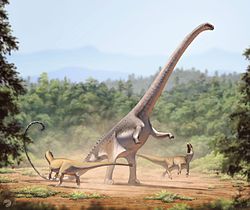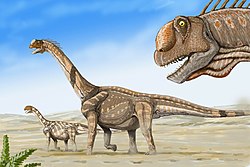Top Qs
Timeline
Chat
Perspective
List of dinosaurs of the Morrison Formation
From Wikipedia, the free encyclopedia
Remove ads
The Morrison Formation is a distinctive sequence of Upper Jurassic sedimentary rocks that is found in the western United States, which has been the most fertile source of dinosaur fossils in North America. It is composed of mudstone, sandstone, siltstone, and limestone, and is light gray, greenish gray, or red. Most of the fossils occur in the green siltstone beds and lower sandstones, relics of the rivers and floodplains of the Jurassic period.
Remove ads
Fauna comparisons
The fauna of the Morrison Formation is similar to the ones found in the coeval rocks of the Tendaguru and Lourinhã formations from Tanzania and Portugal respectively,[1] mostly with the second. Some genera are shared between the Morrison and Lourinhã, such as Torvosaurus,[2] Ceratosaurus,[3] Stegosaurus, Dryosaurus,[4] and Allosaurus.[5] In sum, Morrison Formation has 37 valid genera of dinosaurs.
Remove ads
Ornithischians
Summarize
Perspective
The herbivorous ornithischian dinosaurs were diverse but not as common as sauropods in the Morrison. Fruitadens, previously known as the "Fruita Echinodon", was a heterodontosaurid. Stegosaurs included Hesperosaurus mjosi, Stegosaurus (S. ungulatus and S. stenops), and Alcovasaurus longispinus. Ankylosaurs were unknown in the formation until the 1990s. Two have been named: Gargoyleosaurus parkpinorum and Mymoorapelta maysi. Small neornithischians included Nanosaurus agilis, Enigmacursor mollyborthwickae, Laosaurus (L. celer and L. gracilis), Drinker nisti, Othnielia rex, and Othnielosaurus consors (the last three of which are now considered synonymous with Nanosaurus). Ornithopods were represented by Dryosaurus (D. altus and D. elderae), Uteodon aphanoecetes, which is currently known only from Dinosaur National Monument, and the larger, more common Camptosaurus dispar. All of the aforementioned ornithopod genera were early iguanodonts, the group that gave rise to the duck-billed dinosaurs.
Neornithischians
Color key
|
Notes Uncertain or tentative taxa are in small text; |
Thyreophorans
Ankylosaurs
Color key
|
Notes Uncertain or tentative taxa are in small text; |
Stegosaurs
Color key
|
Notes Uncertain or tentative taxa are in small text; |
Other ornithischians
Color key
|
Notes Uncertain or tentative taxa are in small text; |
Remove ads
Sauropods
Summarize
Perspective
Sauropods, the giant long-necked long-tailed four-legged herbivorous dinosaurs, are among the most common and famous Morrison fossils. A few have uncertain relationships, like "Apatosaurus" minimus (possibly a basal titanosauriform) and Haplocanthosaurus. Sauropods including Haplocanthosaurus priscus, H. delfsi, and the diplodocid Brontosaurus yahnahpin appeared in the early stages of the Morrison. The middle stages were dominated by familiar forms such as the giraffe-like Brachiosaurus altithorax, which were uncommon, but related camarasaurids, like Camarasaurus supremus, C. grandis, C. lentus, and Cathetosaurus/Camarasaurus lewisi, were very common. Also common were long, low diplodocids, like Apatosaurus ajax, A. louisae, Brontosaurus excelsus, B. parvus, Barosaurus lentus, Diplodocus longus, D. carnegii, Galeamopus and Dyslocosaurus polyonychius.
By the late Morrison, gigantic diplodocids (or similar species) had appeared, including Diplodocus hallorum (formerly Seismosaurus), Supersaurus vivianae, Amphicoelias altus, and Maraapunisaurus fragilimus. Smaller sauropods, such as Suuwassea emiliae from Montana, tend to be found in the northern reaches of the Morrison, near the shores of the ancient Sundance Sea, suggesting ecological niches favoring smaller body size there compared with the giants found further south.[55]
Haplocanthosaurids
Color key
|
Notes Uncertain or tentative taxa are in small text; |
Rebbachisaurids
Color key
|
Notes Uncertain or tentative taxa are in small text; |
Dicraeosaurids
Color key
|
Notes Uncertain or tentative taxa are in small text; |
Diplodocids
Color key
|
Notes Uncertain or tentative taxa are in small text; |
Macronarians
Color key
|
Notes Uncertain or tentative taxa are in small text; |
Remove ads
Theropods
Summarize
Perspective
Theropod dinosaurs, the carnivorous dinosaurs, came in several different types. The less derived types, the ceratosaurs and megalosaurids, included Ceratosaurus nasicornis, C. dentisulcatus, C. magnicornis, and the megalosaur Torvosaurus tanneri (including Edmarka rex). Allosaurids included the common Allosaurus fragilis (including Epanterias amplexus), A. jimmadseni and A. anax (previously referred to Saurophaganax maximus).
Indeterminate theropod remains have been recovered in Utah, with indeterminate ceratosaur remains formerly considered referable to Elaphrosaurus recovered in Colorado. Indeterminate theropod tracks have been recovered from both Utah and Arizona.[89]
Allosauroidea
Color key
|
Notes Uncertain or tentative taxa are in small text; |
Ceratosaurs
Color key
|
Notes Uncertain or tentative taxa are in small text; |
Coelurosaurs
Coelurosaurs, the group of theropods most closely related to and including birds, included Coelurus fragilis, Ornitholestes hermanni, Tanycolagreus topwilsoni, the possible troodontid Koparion douglassi, the definite troodontid Hesperornithoides, and the early tyrannosauroid Stokesosaurus clevelandi.
Color key
|
Notes Uncertain or tentative taxa are in small text; |
Megalosauroids
Color key
|
Notes Uncertain or tentative taxa are in small text; |
Remove ads
Eggs

Dinosaur eggs have been found in Utah.[14]
Tracks
Summarize
Perspective
Ornithopods
Morrison ornithopod trace fossils are represented by three toed tracks which are generally small.[6] The toes of Morrison ornithopod tracks are usually more widely splayed than the theropod tracks preserved in the formation.[6]
Stegosaurs
Stegosaur tracks were first recognized in 1996 from a hindprint-only trackway discovered at the Cleveland-Lloyd quarry, which is located near Price, Utah.[41] Two years later, a new ichnogenus called Stegopodus was erected for another set of stegosaur tracks which were found near Arches National Park, also in Utah.[41] Unlike the first, this trackway preserved traces of the forefeet. Fossil remains indicate that stegosaurs have five digits on the forefeet and three weight-bearing digits on the hind feet.[41] From this, scientists were able to successfully predict the appearance of stegosaur tracks in 1990, six years in advance of the first actual discovery of Morrison stegosaur tracks.[41] Since the erection of Stegopodus, more trackways have been found, however none have preserved traces of the front feet, and stegosaur traces remain rare.[41]
Theropods
Indeterminate theropod tracks have been recovered from both Utah and Arizona.[89]
Remove ads
Footnotes
References
Wikiwand - on
Seamless Wikipedia browsing. On steroids.
Remove ads






































